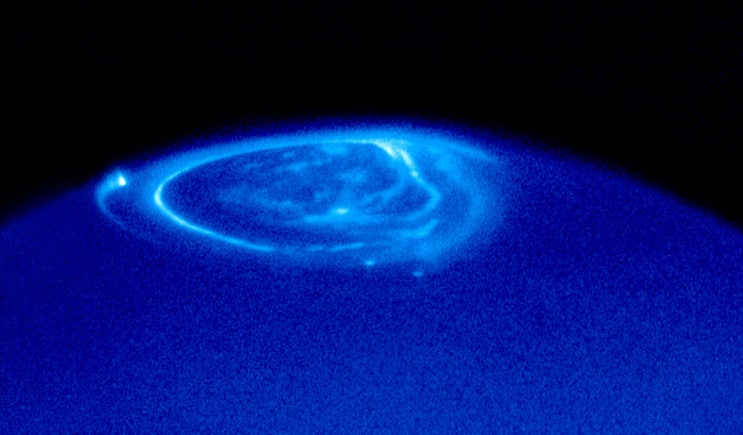

| Visitors Now: | |
| Total Visits: | |
| Total Stories: |

| Story Views | |
| Now: | |
| Last Hour: | |
| Last 24 Hours: | |
| Total: | |
Io’s Volcanism Controls Jupiter’s Auroral Activity
read more at Anne’s Astronomy News http://annesastronomynews.com/
Jupiter’s volcanic moon Io spews out volcanic gas, which reaches its atmosphere and becomes ionized, forming what is known as the Io plasma torus. This plasma torus can interact with Jupiter’s magnetosphere, possibly affecting auroral activity there.

This ultraviolet image of Jupiter was taken with the Hubble Space Telescope Imaging Spectrograph (STIS) on 26 November 1998 at a distance of 700 million km from Earth. The bright emissions above the dark blue background are auroral lights, similar to those seen above the Earth’s polar regions. On Jupiter one can normally see three different types of auroral emissions:
a) a main oval, centred on the magnetic north pole
b) a pattern of more diffuse emissions inside the polar cap and
c) a unique auroral feature showing the ‘magnetic footprints’ of three of Jupiter’s satellites. These ‘footprints’ can be seen in this image: from Io (along the left-hand limb), from Ganymede (near the centre just below the reference oval) and from Europa (just below and to the right of Ganymede’s auroral footprint). These emissions are unlike anything seen on Earth. Credit: NASA, ESA & John T. Clarke (Univ. of Michigan)
To help determine whether Io’s volcanic activity affects Jupiter’s magnetosphere, Yoneda et al. analyzed ground-based observations of Jupiter’s sodium nebula, which provides an indication of Io’s volcanic activity and plasma content in the Io plasma torus, along with satellite-based measurements of radio emission called HOM emission, which is a sign of Jupiter’s auroral activity.
Jupiter’s volcanic moon Io. Image Credit: NASA/JPL/University of Arizona
They observe that Jupiter’s sodium nebula was enhanced in late May through early June 2007, indicating that Io’s volcanic activity increased during that period. The researchers observe that shortly after this enhancement began, Jupiter’s HOM emission intensity decreased.
As a result, the authors conclude that increased volcanic activity on Io lessens auroral activity in Jupiter’s magnetosphere.
The reasearch paper by Yoneda et al: “Io’s volcanism controls Jupiter’s radio emissions” is published in the Geophysical Research Letters, doi: 10.1002/grl.50095, 2013.
Source: The American Geophysical Union (AGU)
n/a
2013-01-29 10:51:12
Source: http://annesastronomynews.com/ios-volcanism-controls-jupiters-auroral-activity/
Source:



